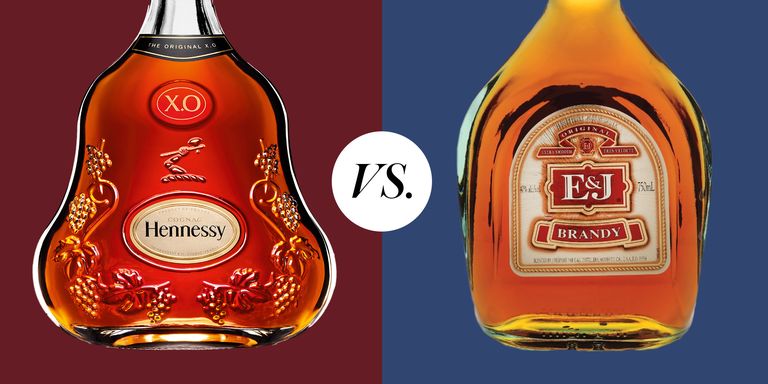
Victor Hugo called cognac the "liquor of the gods." It's become known as a symbol of French luxury, the best brandy money can buy (yes, cognac is a brandy). Here's a primer on the liquors.
In a nutshell, Brandy is any distilled spirit made from fermented fruit juice. Cognac is a specific type of barrel-aged brandy made in the Cognac region of France.
Where do they come from?
Cognac must come from the Cognac region in Southwest France, which is known for its superior terroir (the soil, climate, and topography that contribute to grape-growing conditions).
Brandy can come from anywhere in the world.
How are they made?
Brandy generally refers to a distilled spirit made from fermented fruit juice. It can be produced using grapes or fruit. (Calvados, for instance, is an apple brandy from the Normandy region in France).
Cognac, meanwhile, must be made from white grapes from one of six different terroirs; the Ugni Blanc grape variety is its primary ingredient, and grapes from "Grande Champagne" terroir are the most coveted. The liquid must be distilled twice, and its distillation season lasts from October 1 through March 31.
What glassware should they be served in?
When it comes to enjoying brandy and cognac, the choice of glassware plays a crucial role in enhancing the overall tasting experience. These exquisite spirits deserve the right vessel to unlock their full potential, allowing you to savor their complex aromas and flavors. Here are the types of glassware that are ideal for serving brandy and cognac:
Snifter or Brandy Balloon: The classic choice for brandy and cognac, the snifter or brandy balloon features a wide bowl that narrows at the top. This design allows you to gently warm the spirit with your hand while concentrating the aromas within the glass. Swirling the liquid and taking in its scent through the wide surface area enhances the tasting experience.
Tulip Glass: A tulip-shaped glass is another excellent option for these spirits. Similar to the snifter, it concentrates the aroma, and its long stem prevents the heat from your hand from affecting the temperature of the liquid. This glass is often favored for premium cognacs.
Copita: The copita is a smaller and narrower version of the brandy snifter, making it a perfect choice for those who prefer smaller sips. It's often used for tasting high-quality brandies and aged cognacs.
Glencairn Glass: Originally designed for whisky, the Glencairn glass has become a popular choice for brandy and cognac enthusiasts. Its tulip shape and wide bowl make it suitable for capturing the nuances of these spirits.
Tasting Glasses: Various tasting glasses designed for specific brands and expressions can also be used to appreciate the unique characteristics of different brandies and cognacs. These glasses often come from the distilleries themselves and are tailored to their products.
When selecting the right glassware for brandy and cognac, remember that it's essential to handle the spirit with care. A proper glass not only elevates the tasting experience but also showcases the beauty of these refined and aged spirits.
What about blending and aging?
Blending and aging are two essential processes that shape the character and quality of brandy and cognac, turning simple distilled wine into complex, aromatic elixirs that have been enjoyed for centuries. Here's a brief overview of these critical steps in the production of these distinguished spirits:
Blending:
Blending is an art in the world of brandy and cognac production, as it involves marrying different eaux-de-vie (grape spirits) to create a harmonious and consistent final product. Master blenders are highly skilled individuals who select and combine eaux-de-vie of various ages, grape varieties, and vineyard sources to achieve the desired flavor profile.
The goal of blending is to balance the spirit's characteristics, taking into account factors like fruitiness, spiciness, and depth. Each house or distillery has its secret recipe, often handed down through generations. The art of blending allows producers to create unique and consistent products year after year.
Aging:
Aging is the second crucial step in the production of brandy and cognac. After distillation, the eaux-de-vie are placed in oak barrels for a prolonged maturation period, which can last anywhere from a few years to several decades. The aging process imparts complex flavors, aromas, and a smooth mouthfeel to the spirit.
The choice of oak barrels, their age, and the environmental conditions of the aging cellar all play a significant role in shaping the final product. Oak barrels allow the spirit to interact with the wood, drawing out compounds like vanillin, tannins, and other aromatic compounds. Additionally, evaporation, known as the "angel's share," contributes to concentration and richness.
As brandy and cognac age, they undergo transformation, becoming more refined and nuanced. The interaction with the wood and the slow oxidation process are crucial for developing the spirit's distinct flavors, ranging from fruity and floral notes in younger expressions to deep, complex, and spiced characteristics in older ones.
In conclusion, the intricate processes of blending and aging are the heart of brandy and cognac production, resulting in sophisticated, multi-layered spirits that have earned their place among the world's most revered libations. The expertise and tradition behind these techniques are part of what makes brandy and cognac so beloved by connoisseurs worldwide.
